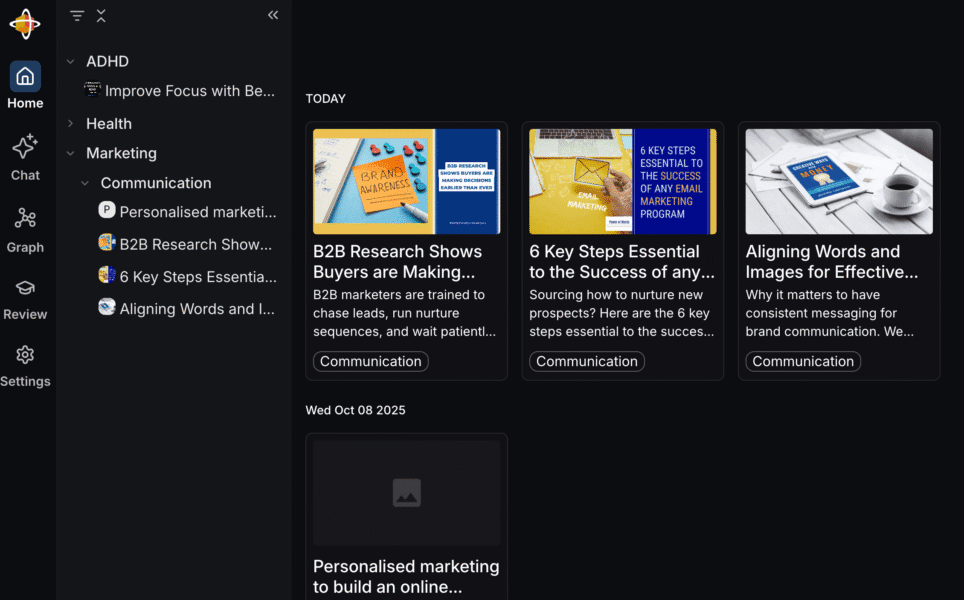Do you understand how to leverage your long-term blog or news writing? It’s not just about sticking to a niche.
The inside secret to writing great content is intersecting it with past content
If you don’t intersect your content on a blog or vlog, you will be creating narrow channels of information that may only resonate with half your audience. Or it may say different ideas, which may create an appearance of not knowing what you think. Yet, it’s so easy to get lost with what’s been said over time, if posting or video logging weekly. I’ve lived it.
Nevertheless, I’ve long known that our brain is a powerhouse of connected ideas – as demonstrated so well by Tony Buzan’s Mind Maps. The human brain processes information through distinct yet interconnected pathways, with visual and language-based parts being connected. Understanding this means valuing both the visual and the textual parts of online content… creating a better overall message. (Tony Buzan lived 1942-2019).
As I said in a prior post:
“When selecting visuals, it is essential that they align closely with the accompanying language. This alignment not only reinforces the theme presented but also ensures clarity and reinforces retention of the information.”
Design elements, including colour schemes, typography, and layout, play a crucial role in achieving the harmonious alignment of words and images. Designers carefully select colour schemes and styles to evoke the desired emotional response, just as we writers select the language that will provoke a response.
Consistency of brand
Maintaining consistency across various communication channels, such as social media, ads or websites, ensures that the audience receives the same message, thus strengthening brand identity. This works whether it’s a personal brand or a company or charity.
To create cohesive content, writers and designers (or your content creator) should establish a clear brand identity that dictates the tone, style, and imagery used across all content.
Using style guides or brand templates [link for authors] to maintain consistency in typography, colour sets and graphic elements will help you as creator or help your Content Manager. As will implementing a review process to ensure that text and images complement one another.
Collaboration
Collaboration between writers and designers is essential during the drafting phase. Utilising various tools, such as Canva, with its brand kit, templates and simple post scheduler, and project management tools like Trello or Notion can streamline the process of drafting appropriate content. With Notion, it will track adjustments to the components from all parties, and any added client can leave comments. With Canva, clients can be given access to designs or simply to leave comments.
As content manager, doing regular reviews can lead to refinements that elevate the quality of the material produced. More about content improvement is here.
Ultimately, by following these practical tips and embracing a collaborative approach, writers and designers can effectively create cohesive content that resonates with their audience while reinforcing their brand identity.
Memory aid
I talked before about forgetting what ideas we’ve said in a vast realm of content. There is now a tool which can capture all your words and videos for you to pull out summaries, ideas, and re-learn something you spoke about. You can save other people’s long videos, podcasts, your own notes or your Substack articles.
It’s called Recall. For those with ADHD, it’s a game changer. Going back to find something specific is so hard for us fast-movers, but this tool can pull it up by topic keyword or through a topic map. You can chat (interact) with what you wrote, for example, I asked it to list the six essential steps of email marketing (after saving the long blog post).
Another feature, the Recall Review, helps you remember the content you save to Recall. First, you generate questions for specific knowledge cards you want to remember. Then, Recall will prompt you to answer the questions at certain points in time to maximise your retention on the topic.
Or you can simply chat and ask all the knowledge saved to Recall what you thought about X, or what so-and-so said about Y.
Get 10 free Recall cards and see what I mean. Give it a try for free. https://www.getrecall.ai?token=bFlBB3ro
Writing great content is super hard these days, because it’s all too easy to use a Chat LLM and not do the thinking for yourself. What do I believe? What is my value-add?
It’s also hard because influential leaders have said all the things, and this brings up our imposter syndrome. And it is hard if we haven’t done the training to afford the great ideas to come out.
Outsourcing Content Management
You can perhaps see why I’d rather work with the leader on their content process and final look and feel, than do it 100% for them. The educator, or subject matter expert, is the one with knowledge, with stories, with the personality which I’ll take note of. That means they need to be heavily involved in the idea creation or else have available IP.
You might also want new leads or connections. Due to LinkedIn’s rules, a person must send connection requests only through their own account and should not delegate this to a virtual assistant.
However, LinkedIn content managers can do the bulk of the work and schedule it through using OAuth, which allows us to connect certain scheduling tools to a person’s LinkedIn without needing passwords. These tools can only perform actions allowed within the API scopes granted – for example, not all functions such as editing full profiles, managing connections, or bulk operations are permitted without special permissions.
There are limits in order to prevent abuse, such as number of connection requests per week or messaging non-connections. It’s not about the sheer numbers anyway, but rather the relationship of the new person’s needs to your message.
For a chat about your content management needs, just book in with Jennifer for a Content needs call.


